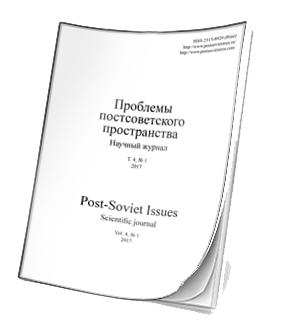
"Post-Soviet Issues" is a leading Russian peer-reviewed scientific journal established in 2014 and released with a frequency of four issues per year (quarterly).
ISSN: 2313-8920 (Print), ISSN: 2587-8174 (Online)
It publishes original research articles and reviews focused on the political, economic, social and historical dynamics of the post-Soviet area, including the Caucasus, Central Asia, Eastern Europe and Russia. The journal provides a multidisciplinary platform for rigorous academic inquiry. The authors of the journal are experienced Russian researchers from prominent Russian universities, institutes of the Russian Academy of Sciences, leading experts from the post-Soviet countries as well as from other states. It also accepts articles by postgraduate and doctoral students in Russian and English devoted to the analysis of various problems of the post-Soviet countries.
Since 2014 the journal has been implementing a strategy of internationalization and inclusion in international academic databases.
Key areas of the journal are: urgent international problems and history of interstate relations in the post-Soviet area, issues of regional security, political and economic interaction of the post-Soviet countries with the states of Asia, Europe, South America and the USA, cooperation within the Eurasian Economic Union (EAEU), Shanghai Cooperation Organization (SCO), Commonwealth of Independent States (CIS), international educational interaction. The thematic focus of the journal is reflected in the names of the permanent sections: International Relations and Global Policy, Politics, Economy, History and Religion.
The journal is included in the List of the Russian reviewed academic journals in which the main scientific results of the theses for the bestowing of the academic degrees of doctors and candidates of sciences are to be published as recommended by the Supreme Attestation Commission (VAK) under the Ministry of Education and Science (came into force on July 18, 2019) in the following areas:
5.5.2. Political Institutions, Processes, Technologies (Political sciences)
5.5.4. International relations, Global and Regional studies (Political sciences)
5.2.5. World Economy (Economic sciences)
5.6.7. History of International Relations and Foreign Policy (Historical sciences)
Target audience of "Post-Soviet Issues": researchers who study the problems of the post-Soviet countries and also focus on the analysis of the policies that extra-regional states carry out in the region.
All submitted articles undergo a rigorous double (blind) peer-review process based on initial editorial screening and assessment by independent international experts. See the detailed peer-review policy.
































